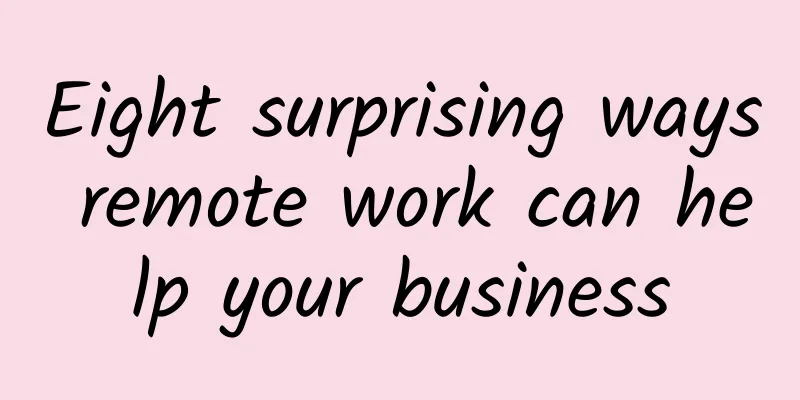Eight surprising ways remote work can help your business

|
The rise of remote work is arguably the biggest change to the way we work since the advent of the internet-connected PC. Yet there are still many unknowns to be determined.
When will the remote working model under the background of the epidemic end? We don’t know! How many of those currently working from home will return to the office? We don’t know! Overall, is remote work good for business? Or is it bad? Again, no one can give a definitive answer! But we’ve learned a lot not only about remote work, but also about office work—and the entire way of doing business over the past few decades. Businesses of the future will work better because of what we’ve learned. Here are 8 ways remote work can help improve your business: 1. Team, project, and task management tools are better than MBWASurprisingly, in the 21st century, most managers, department heads, team leaders, and project leaders still practice “management by wandering around” (MBWA), a strategy in which senior executives use their time to frequently visit various offices to obtain richer and more direct information about employees’ work problems and to understand their employees’ work difficulties in a timely manner. There’s just one problem: Anyone who knows about this strategy can pretend to be working hard at their computer, even if they’re actually shopping on Amazon or posting pictures on Facebook. Anyone staring out the window will appear to be slacking off, even if they’re thinking about an idea that could create millions of dollars for the business. Some companies are experimenting with new MBWA technology from companies like iMonitorSoft and EfficientLab -- software that uses cameras, keyloggers and desktop screen capture to ensure people are focused on their work. In most cases, this isn't a recipe for retaining top talent. On the contrary, people don't want their companies to spy on their homes, and many would leave out of disgust. What's more, remote worker monitoring tools are easily hacked. In the post-epidemic era, companies are better off focusing on the work delivered rather than observational guesswork. Products such as Asana, Basecamp, Trello, Jira, Podio, Taskworld, Monday.com, etc. combine team and individual task monitoring to focus on completion time rather than "they type a lot." 2. Zero Trust is Essential for SecurityThe surge in unplanned remote work at the start of the Covid-19 pandemic last year radically expanded the attack surface for organizations around the world. Specifically, home offices often involve many applications on many devices used by many users (family members and guests) all accessing the same network, sometimes sharing devices. In these cases, a zero-trust security model is obviously a good idea. (Zero trust is an architecture in which every device, application, and user must be individually authenticated and authorized based on the resources they access.) Likewise, zero trust is now needed in office environments, even those with strong perimeter defenses and good physical security, to ensure widespread remote work is effective. 3. Living in a high-cost city to get a high-paying job is a wasteOne of the reasons knowledge workers move to big cities is that historically that’s where the high-paying jobs are. And where the high-paying jobs are, the average cost of living is much higher. This is especially true in Silicon Valley, where a family making $200,000 a year can only live a middle-class life because the average house costs $1.2 million, and the cost of food, gas, clothing, insurance, and everything else is much higher than in other cities in the country. It would make more sense for everyone if employees could live wherever they wanted and the company paid less. This is a controversial point, as some commentators say workers shouldn’t face financial hardship for teleworking. That’s true if teleworking is part-time and workers are still required to live in expensive cities. But if people can live anywhere — in the suburbs, in small rural towns, in remote forests, or, say, in Costa Rica — and still do their jobs, the wasteful chain of events that keeps workers living at a high cost and demanding higher wages might finally be broken. 4. Remote office communication tools are also more suitable for office workWhat we’ve learned during the pandemic is that basing all meetings on in-person gatherings is not ideal. In this scenario, meetings mostly benefit only the participants in the room, and anyone on the speakerphone is treated as a “second-class citizen” or a burden to the meeting. Video conferencing using Zoom, Microsoft Teams, Slack, BigBlueButton, BlueJeans, Whereby, GoToMeeting, Cisco WebEx, Google Meet, and others puts everyone on an equal footing to participate and share slides, documents, charts, and other content. In the future, whether we work remotely, in-house, or more likely, hybrid, the meeting tools that the pandemic has forced us to use will improve the future of meetings because we’ve all become accustomed to them. 5. Remote work is more environmentally friendly than office workA new study conducted by Alliance Virtual Offices found that, on average, each employee working from home reduces their carbon footprint by approximately 1,800 pounds per year. Multiply that by the number of remote employees and the result is staggering. Allowing remote work is arguably one of the most effective ways a company can contribute to reducing greenhouse gases. 6. Low office efficiencyThe Wall Street Journal recently reported that some remote workers are taking advantage of the “circumstances” to get a second remote job and make each employer think they are working only their one job. (The “circumstances” here refer to the lack of performance management systems necessary to ensure productivity in a remote work model.) The article stated, “Many remote workers say they work no more than 40 hours a week at multiple jobs combined.” To the extent that it’s real and widespread enough to be a trend, it reveals deep inefficiencies in how work is managed and measured. It also reminds us how much unproductive time employees spend getting ready for work and commuting to get off work. Research by Alliance Virtual Offices found that employees in New York save 15.2% of their time by “not commuting.” 7. Most business travel is unnecessary and expensiveBusiness travel has been hit hard by lockdowns and remote work, and companies around the world are realizing the huge time and financial savings that can be made when most business travel is replaced by Zoom calls and other online interactions. While the dramatic reduction in business travel caused by the pandemic is not directly related to post-pandemic remote work, the tools that have gone mainstream — especially the newfound discovery and habit of video conferencing — have proven that they can replace at least some business travel. 8. Hybrid work is better than remote or office workThe truth is, some people’s personalities or work styles are better suited to in-person collaboration. Others crave the freedom and independence of remote work. Each type works best in their own right. This also creates conditions for “hybrid working”, where extroverted workers can choose an office environment while introverted workers can continue to work remotely. A host of new remote work tools are available to all. Right-sizing work locations can optimize performance, improve employee retention and happiness, and boost an organization’s competitiveness. The bottom line is, we can’t know exactly how the remote work trend will ultimately pan out. But we do know that the knowledge we gain by rushing into remote work will greatly improve the way business is done in the future. |
<<: 5G is changing society, but is millimeter wave still missing?
>>: Why is 5G important for the Internet of Things?
Recommend
If your HTML is full of Divs, be careful
Students who do front-end development know that t...
The hidden threat of smart home privacy leakage comes from the router
In our daily life, we can use smartphones to cont...
HostDare Double 11: 35% off Los Angeles KVM/CN2 GT annual payment starting from US$25.99
HostDare, which has been silent for almost a year...
Private wireless networks provide secure solutions for digital transformation
When many businesses first installed wireless IoT...
Does Snowflake's popularity mean Hadoop is dead? What exactly is a big data system?
Any technology will go through a process from hig...
[Black Friday] AlphaVPS: AMD Ryzen series from €15.99/year, large hard drive VPS from €19.99/year, Los Angeles/Germany/Bulgaria data centers
Bulgarian hosting provider AlphaVPS also launched...
Sending Messages - RocketMQ Knowledge System (II)
[[410032]] In the previous article, we got to kno...
The digitalization journey of Hengshun
[[395022]] In 1840, during the reign of Emperor D...
Overview of Honeynet Technology Based on SDN
The development of cloud computing and virtualiza...
Summary of precautions and common problems in the use of twisted pair cables in weak current engineering
Twisted pair wire is the most commonly used trans...
Research on 5G promoting industrial information transformation and upgrading
Three years after 5G was put into commercial use,...
Mellanox sold more than 2.1 million Ethernet cards in the first three quarters of 2018
Mellanox increases its market share in high-perfo...
How mature is 5G private network?
Data shows that as of the end of September, the t...
Will enterprises have dedicated 5G networks in the future?
5G networks bring many benefits to smartphone use...
Donghua Netzhi Jiang Hua: Load balancing + anti-unification is the most popular among users, and security demand will be stronger next year
[51CTO.com original article] Using the Internet t...









